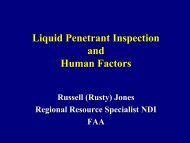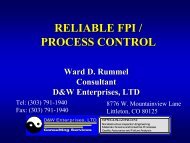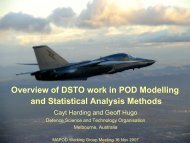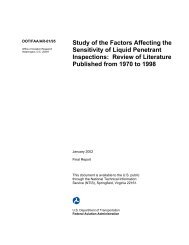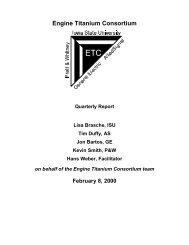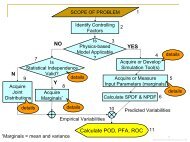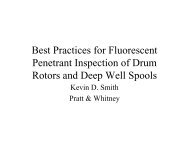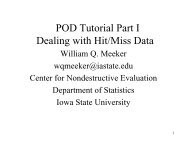Engine Titanium Consortium - Center for Nondestructive Evaluation ...
Engine Titanium Consortium - Center for Nondestructive Evaluation ...
Engine Titanium Consortium - Center for Nondestructive Evaluation ...
You also want an ePaper? Increase the reach of your titles
YUMPU automatically turns print PDFs into web optimized ePapers that Google loves.
used to estimate the size of all defects found in the contaminated heat. From this size estimate and<br />
the measured response, an enhanced data base <strong>for</strong> fine tuning the model <strong>for</strong> the response of<br />
naturally occurring flaws will be available. In addition, in<strong>for</strong>mation about billet flaws gained from the<br />
related <strong>for</strong>ging studies (i.e., from TRMD); and from direct comparison of multizone and conventional<br />
ultrasonic inspection system per<strong>for</strong>mance, will be considered. Based on this in<strong>for</strong>mation, integrated<br />
in the context of the new methodology, updated POD estimates will be made and provided to RISC<br />
and TRMD.<br />
POD <strong>for</strong> Nickel Billet: The new methodology will be implemented on ultrasonic inspection of nickel<br />
billet analogous to that used <strong>for</strong> titanium alloys in Phase I. This will draw heavily on the modeling<br />
work of Phase I, and on results of fundamental studies and model developments planned <strong>for</strong> Phase<br />
II. Based on those fundamental studies, flaw response models will be developed <strong>for</strong> white spots<br />
and other defects from the critical flaw list. Flaw response data and noise data will be gathered,<br />
including any pertinent results from the pilot lot inspection in Subtask 1.1.2 as well as<br />
measurements on synthetic white spots in Subtask 1.1.1. These data will be used as the basis <strong>for</strong><br />
initial estimates of nickel billet POD analogous to that employed <strong>for</strong> Ti-billet in Phase I, extended<br />
where possible by subsequent improvements in the methodology, as developed in Phase II.<br />
Measurements of calibration standards and chord blocks will be used <strong>for</strong> validation as appropriate.<br />
A study will be conducted of the effects of calibration response variability and determination of flaw<br />
size on the accuracy of POD predictions.<br />
Comparison of Inspection Systems - Use of the Random Defect Block: This section will be updated<br />
in the next quarter to reflect all changes currently being made.<br />
Objective/Approach Amendments:<br />
The objective and general approach remain as originally proposed in July 1998 with the exception<br />
of work related to the Random Defect Block. A proposal <strong>for</strong> new work was submitted to the FAA in<br />
February 2000. Per FAA technical redirection, on March 17, 2000, all ef<strong>for</strong>t other than that related<br />
to the RDB was suspended. The RDB recovery program was initiated in May 2000. On March<br />
14, 2001, guidance was received regarding resumption of the technical work on subtask 3.1.1 with<br />
the initial activity being the revision of program schedules and technical path to account <strong>for</strong> the RDB<br />
results.<br />
Progress (January 1, 2002 – March 31, 2002):<br />
In this period, our CBS reconstruction work was focused on defect B1AW2-B (POD 9). Because<br />
this defect is very close to the surface of the billet, side 1 of the cube block retained the original<br />
billet surface to prevent the defect from being accidentally cut-off. The curved surface geometry,<br />
however, had caused some degree of accessibility problem in carrying out ultrasonic scans from<br />
neighboring sides 2, 4, 5 and 6 (Fig. 1). The footprint of the 5 MHz insonifying transducer beam<br />
might be partially off the edges of one or more of these sides, resulting in signal loss. Furthermore,<br />
other than vertical edges of the cube block, there were no fiducial marks available in the<br />
micrographs to help align the successive cross-sections of the defect. This has made the<br />
micrograph re-alignment in the vertical direction quite difficult and uncertain. Nevertheless, both<br />
geometric and ultrasonic models of this defect have been completed to the best our capacity. The<br />
geometric model consists of one flat void part with four branches, and was built using 6 geometric<br />
Quarterly Report – January 1, 2002 –March 31, 2002<br />
print date/time: 6/6/2002 - 8:39 AM – Page 89



